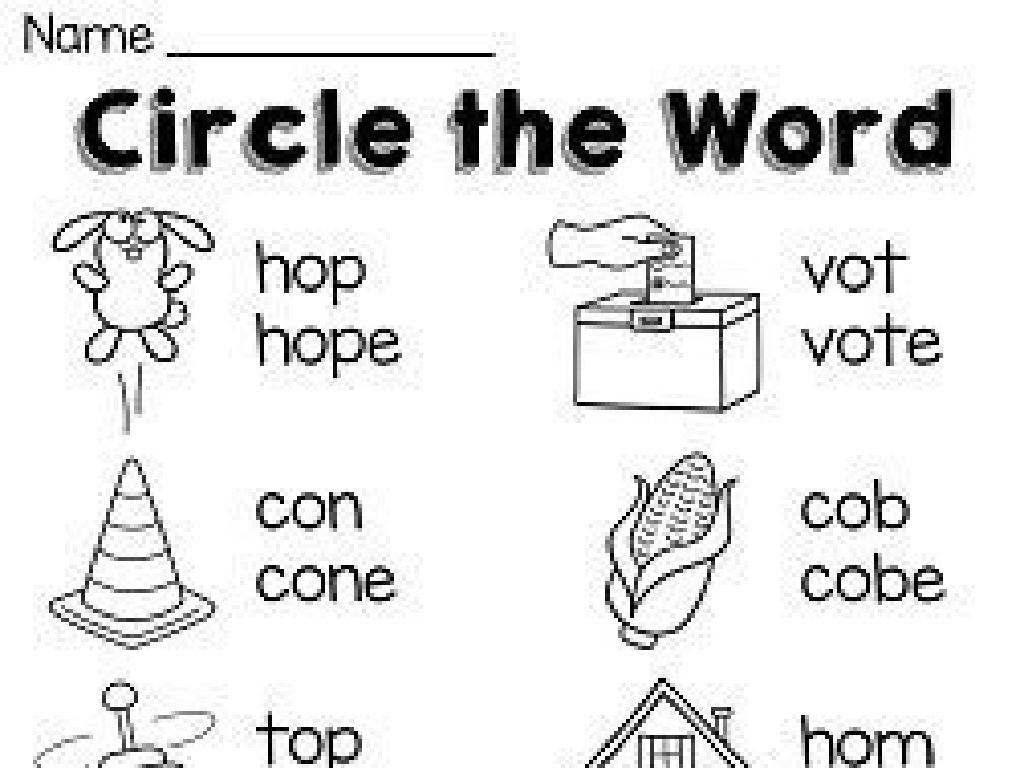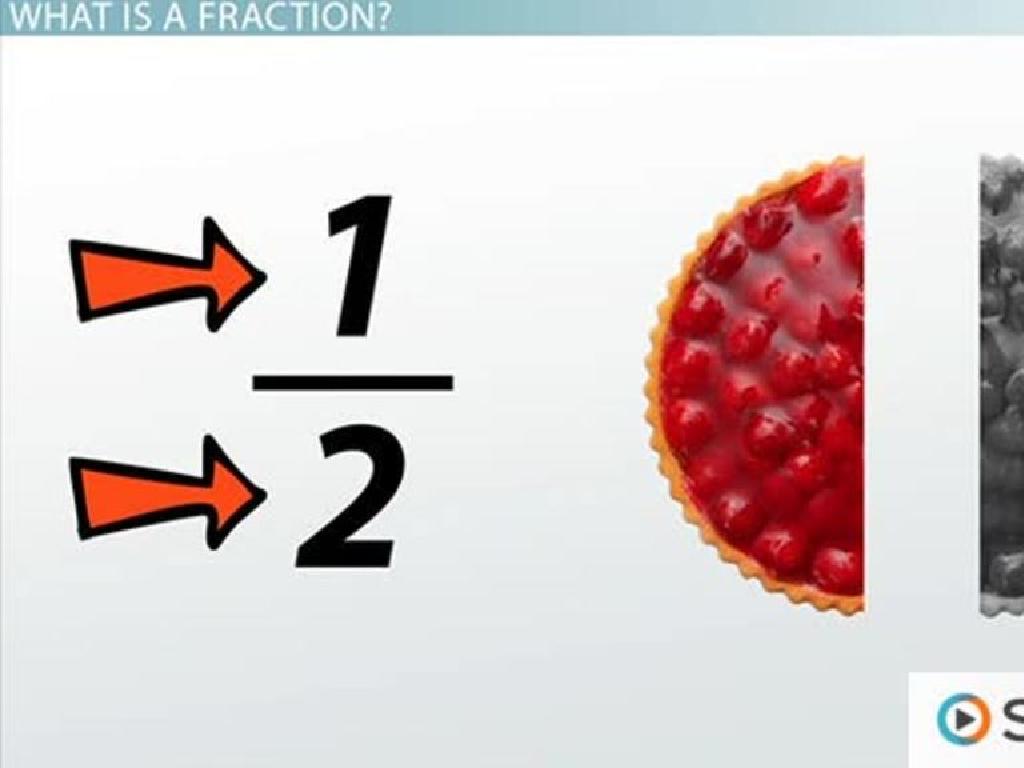Multiply Fractions By Whole Numbers Using Number Lines
Subject: Math
Grade: Fourth grade
Topic: Multiply Fractions And Whole Numbers
Please LOG IN to download the presentation. Access is available to registered users only.
View More Content
Today’s Adventure: Multiplying Fractions by Whole Numbers
– Grasp the concept of fractions
– A fraction represents a part of a whole
– Recognize whole numbers
– Whole numbers are complete units without fractions
– Learn to multiply fractions by whole numbers
– Use a number line to visualize multiplying fractions step by step
– Understand the importance of this skill
– This skill is useful in real-life situations like cooking or dividing objects
|
Begin the lesson by ensuring that students have a solid understanding of what fractions and whole numbers represent. Use visual aids like pie charts or objects to demonstrate fractions. Explain that whole numbers are integers without any fractional parts. Introduce the concept of multiplying fractions by whole numbers using number lines to provide a visual representation of the process. Emphasize how this skill is applicable in everyday scenarios, such as when a recipe needs to be doubled or when sharing items equally among a group. Encourage students to practice with examples and to ask questions if they’re unsure about the steps involved.
Understanding Fractions
– A fraction is part of a whole
– Numerator and denominator explained
– Top number (numerator) shows how many parts we have. Bottom number (denominator) shows how many equal parts the whole is divided into.
– Example: 1/2 of a pizza
– If a pizza is cut into 2 equal slices, 1/2 means we have one of those slices.
– Visualizing fractions on a number line
– A number line can help us see fractions by marking off equal parts between whole numbers.
|
Begin by explaining that a fraction represents a part of a whole, such as a piece of pizza. Clarify the roles of the numerator and the denominator in a fraction. Use a relatable example, like a pizza cut into equal parts, to illustrate the concept of a fraction. Introduce the idea of using a number line to visualize fractions, which will be a foundation for understanding how to multiply fractions by whole numbers. Ensure that students are comfortable with the idea of a fraction and a number line before moving on to multiplication.
Understanding Multiplication with Fractions
– Multiplication as repeated addition
– Example with whole numbers
– Like 4 x 3 is the same as adding 4 three times: 4 + 4 + 4
– Multiplying fractions by whole numbers
– It’s similar with fractions, e.g., 1/2 x 4 means adding 1/2 four times
– Using number lines for fractions
– A number line helps us see the additions step by step
|
This slide introduces the concept of multiplication as repeated addition, which is a foundational idea for understanding how to multiply fractions by whole numbers. Start with a simple example using whole numbers to solidify the concept. Then, transition to applying this concept to fractions, explaining that multiplying a fraction by a whole number involves adding the fraction to itself that many times. Use a number line to visually demonstrate this process, as it helps students to see the increments and understand the concept of repeated addition with fractions. Encourage students to draw their own number lines and practice with different fractions and whole numbers.
Multiplying Whole Numbers by Fractions
– Understanding multiplication with fractions
– Whole numbers times fractions
– Multiplying is like finding ‘that many’ parts of a whole
– Visualizing with number lines
– Use number lines to see the parts of the whole
– Example: 3 x 1/4
– Imagine dividing something into 4 parts; take 3 of those parts
|
This slide introduces the concept of multiplying whole numbers by fractions, which is a foundational skill in understanding fractions. Start by explaining that when we multiply a whole number by a fraction, we are essentially looking for ‘that many’ parts of the whole. Use a number line to visually demonstrate this concept, as it helps students to see the fraction as part of a whole. For example, if we multiply 3 by 1/4, we can show this on a number line by first dividing the line into 4 equal parts and then highlighting 3 of those parts. This visual representation reinforces the concept that multiplication by a fraction is the sum of the fraction taken multiple times. Encourage students to draw their own number lines and practice with different whole numbers and fractions to solidify their understanding.
Multiplying Fractions with Number Lines
– Visualize multiplication on number lines
– ‘Steps’ represent fraction multiplication
– Imagine each ‘step’ as adding the fraction again
– Example: Multiplying 1/2 by 4
– 1/2 ‘step’ taken 4 times shows 1/2, 1, 1 1/2, 2 on the line
– Practice with different fractions
– Try 1/3 x 3, 3/4 x 2, and more
|
This slide introduces the concept of using number lines to multiply fractions by whole numbers. It’s crucial to help students visualize the process as repeated addition of the fraction. For instance, multiplying 1/2 by 4 means taking 1/2 step four times on the number line, which helps them see the end result at 2. Use the example provided to demonstrate the process, and then encourage students to practice with different fractions and whole numbers. This visual method supports their understanding of multiplication as repeated addition, which is a key concept in math.
Let’s Practice: Multiplying Fractions on a Number Line
– Example: Multiply 2 by 3/4
– Draw a number line
– Start with a line, label 0 and 2 as our whole numbers
– Mark whole numbers and fractions
– Between 0 and 2, divide into equal parts for 3/4
– Step-by-step demonstration
– Show 3/4 jumps twice, landing on 1 1/2
|
This slide is an interactive class activity to practice multiplying whole numbers by fractions using a number line. Start with the example 2 x 3/4. Draw a number line on the board and have students help in labeling. Divide the segment between 0 and 2 into four equal parts to represent quarters. Then, demonstrate how to make two jumps of 3/4 on the number line, starting from 0. With each jump, mark the new position on the number line. After two jumps, you should land on 1 1/2, which is the product of 2 and 3/4. Encourage students to ask questions and guide them through the process. Prepare to give additional examples if needed and ensure that each student understands the concept before moving on.
Your Turn to Try: Multiplying on a Number Line
– Class activity: Multiply 5 by 2/3
– Draw a number line to solve
– Use a ruler for straight lines and even spacing
– Mark whole numbers and fractions
– Place 0, then mark 1 to 5, and find 2/3 between 0 and 1
– Show multiplication on the line
– Make jumps of 2/3, five times, and see where you land
|
This slide introduces a hands-on activity where students will apply their understanding of multiplying fractions by whole numbers using a number line. Provide each student with a blank sheet of paper and a ruler. Guide them to draw a number line, mark whole numbers from 0 to 5, and then accurately place the fraction 2/3 between 0 and 1. Students will then make five equal jumps of 2/3 along the number line to find the product of 5 and 2/3. This visual method helps solidify the concept of fraction multiplication. Encourage students to share their number lines with the class to discuss different methods and results. This activity can be followed by similar exercises with different numbers to ensure understanding.
Sharing Our Solutions: Number Lines
– Present your number lines
– Share your solution steps
– Explain how you multiplied the fraction by the whole number
– Discuss various methods
– Talk about how your friends solved it differently
– Compare different answers
– Why did everyone get the same or different results?
|
This slide is for a class activity where students will present their work on multiplying fractions by whole numbers using number lines. Each student will show their number line to the class and explain the steps they took to reach their solution. Encourage students to discuss the different methods they used, fostering an environment where diverse approaches are valued. Compare the answers to see if they are the same or different and explore why this might be the case. For the teacher: Prepare to guide the discussion, ensuring that each student understands the concept. Have additional examples ready in case there’s a need for further clarification. Offer praise for effort and correct answers, and provide gentle corrections and explanations for any misunderstandings.
Real-Life Application: Sharing a Cake
– Multiplying fractions in daily life
– Example: Dividing a cake
– If a cake is shared among 4 friends, how much does each get?
– Using number lines to share
– Show division of cake on a number line for visual aid
– Practical understanding of fractions
|
This slide aims to show students how multiplying fractions by whole numbers is applied in everyday situations, such as dividing a cake among a number of people. Start by explaining that fractions represent parts of a whole, and when we multiply them by a whole number, we are finding out how many parts we have in total. Use the example of sharing a cake to make it relatable. If a whole cake is divided into 8 pieces (1/8 each) and we want to share it among 4 friends, we multiply 1/8 by 4. Using a number line, we can visually demonstrate this multiplication and show that each friend gets 4/8 or 1/2 of the cake. This helps students grasp the concept of fractions in a tangible way and understand the practical use of multiplication of fractions by whole numbers.
Class Activity: Fraction Multiplication Game
– Pair up with a classmate
– Use fraction cards to set problems
– Solve your partner’s multiplication
– Explain your solution process
– Use number lines to show how you multiplied the fraction by a whole number
|
This interactive game is designed to help students understand the concept of multiplying fractions by whole numbers using a hands-on approach. Provide each pair of students with a set of fraction cards. Students will use these cards to create and solve multiplication problems. Encourage them to draw number lines to visually represent the multiplication process. As they solve the problems, ask them to explain their thinking to their partner, reinforcing their understanding through teaching. Possible variations of the activity could include using dice to generate random whole numbers for multiplication, creating a competition to see which pair can solve the most problems correctly, or having students create word problems based on the fraction multiplication they’ve done.
Wrapping Up: Fractions & Homework
– Excellent work on fraction multiplication!
– Homework: Fraction multiplication worksheet
– Complete the provided worksheet to reinforce today’s lesson
– Practice makes perfect
– Remember, the more you practice, the better you’ll understand
– Bring any questions to next class
– Don’t hesitate to ask for help if you’re unsure about something
|
Today’s class focused on multiplying fractions by whole numbers using number lines, which is a foundational skill in understanding fractions. For homework, students are assigned a worksheet that will help solidify their understanding of the concept. Encourage them to practice in order to improve their skills. Remind them that it’s okay to have questions and that they should bring any uncertainties to the next class for clarification. This will ensure that all students are confident in their ability to multiply fractions by whole numbers.






